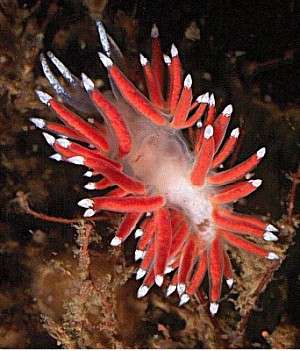
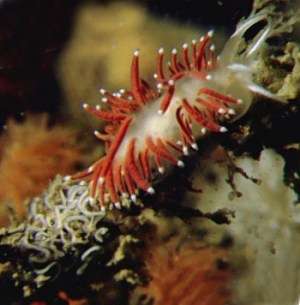
Flabellina gracilis
(Alder & Hancock, 1844)
Order: NUDIBRANCHIA
Suborder: AEOLIDINA
Family: Flabellinidae
DISTRIBUTION
North Atlantic, European coast from France to Iceland, North American coast from Newfoundland to New England.
PHOTO
UPPER: 73 feet (34 meters) off New York, USA. PHOTO: Betsy Hansen.
LOWER: Burghsluis, Oosterschelde, The Netherlands, 10 April 1999. PHOTO: Peter van Bragt.
Grows to about 15mm long. Reported to feed on hydroids Eudendrium ramosum but in deeper water it is found eating Halecium articulosum and Clytia johnstoni.
Comparison from Terry Gosliner message below: 'The main external characteristics for differentiating F. gracilis from F. verrucosa is that the cerata are more distinctly arranged in rows in F. gracilis and there is a more prominent vestige of a notal brim in F. gracilis. Also F. gracilis has a sort of notched head between the junction of the oral tentacles and more elongate anterior margins of the foot'.
Reference:
• Kuzirian, A.M. (1979) Taxonomy and biology of four New England coryphellid nudibranchs. Journal of Molluscan Studies, 45: 239-261.
• Thompson, T.E. & Brown, G.H. (1984) Biology of Opisthobranch Molluscs, Vol 2. Ray Society: London.
Rudman, W.B., 1999 (August 28) Flabellina gracilis (Alder & Hancock, 1844). [In] Sea Slug Forum. Australian Museum, Sydney. Available from http://www.seaslugforum.net/find/flabgrac
Related messages
Flabellina gracilis from Maine, USA
August 28, 2003
From: Alan Shepard
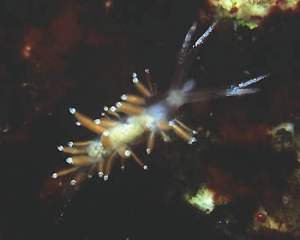
Bill -
Here's another nudibranch from Eastport, Maine, USA. I believe this is Flabellina gracilis. They are plentiful all over the dive site particularly on the granite remains of the old steamship pier that provide a tremendous amount of surface for invertebrates. The granite wall is approximately 10m high and entirely submerged at both low and high tide. It stretches for quite a distance.
This specimen was approximately 12mm long. There are a confusing number of Flabellina species in the area making identification while diving a bit difficult. Most common on the dive site are F. verrucosa , F. pellucida and F. gracilis.
Best wishes,
Alan Shepard
Tolland, CT, USA
alan.chepard@snet.net
Shepard, A., 2003 (Aug 28) Flabellina gracilis from Maine, USA. [Message in] Sea Slug Forum. Australian Museum, Sydney. Available from http://www.seaslugforum.net/find/10848Thanks Alan,
Bill Rudman
Flabellina gracilis from Scotland
May 27, 2002
From: Jim Anderson
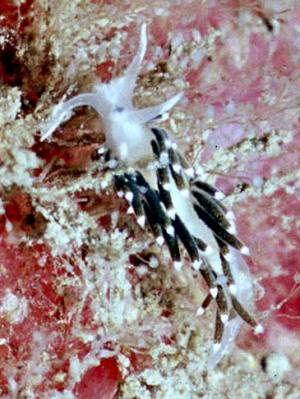
Dear Dr. Rudman,
Here is a photo of Flabellina gracilis from a recent trip to the Scottish west coast. It was identified by Bernard Picton as the varety smaragdina. It was approx 15mm long and was found on Auliston Cliff in Loch Sunart on the west coast on 6 May, 2002.
Jim Anderson
jander4454@aol.com
Anderson, J., 2002 (May 27) Flabellina gracilis from Scotland. [Message in] Sea Slug Forum. Australian Museum, Sydney. Available from http://www.seaslugforum.net/find/7034Thanks Jim,
Bill Rudman
Flabellina gracilis & F. browni
July 22, 2001
From: Bernard Picton
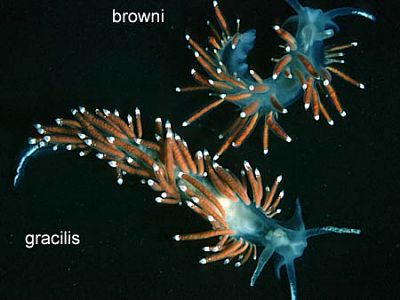
Hi Bill,
Here is a picture of Flabellina gracilis with a juvenile F. browni - note the F. gracilis is full of mature ovotestis whilst the F. browni is translucent throughout and won't be mature until it nearly twice the size of
F. gracilis. There are differences in the cerata - arrangement, spacing, relative sizes, etc but these are hard to put into words - more 'jizz' as the birdwatchers call it.
Locality: Lough Hyne, Co Cork, Ireland. April 1979
Bernard
bernard.picton.um@nics.gov.uk
Picton, B., 2001 (Jul 22) Flabellina gracilis & F. browni. [Message in] Sea Slug Forum. Australian Museum, Sydney. Available from http://www.seaslugforum.net/find/4846Thanks Bernard,
Seeing this photo shows the dangers of attempting to identify nudibranchs from colour photos. In many cases anyone familiar with the living animals will be able to do so quite easily, but in other cases, often when you are least expecting it, the identifier will be easily mistaken. Let this be a caution to anyone who thinks matching 'look-a-likes' in photos is all that is needed to identify a nudibranch.
Best wishes,
Bill Rudman
Flabellina gracilis from the Netherlands
September 4, 1999
From: Peter H. van Bragt

Dear Bill,
Here is a photo of Flabellina gracilis to add to the Netherlands' List.
Location: Burghsluis, Oosterschelde, The Netherlands, 10 April 1999
With best regards
Peter H. van Bragt
Peter.vanBragt@ftn.hsbrabant.nl
van Bragt, P.H., 1999 (Sep 4) Flabellina gracilis from the Netherlands. [Message in] Sea Slug Forum. Australian Museum, Sydney. Available from http://www.seaslugforum.net/find/1232Thanks Peter,
It looks fairly similar on both sides of the Atlantic.
Bill Rudman.
Flabellina gracilis
August 31, 1999
From: Erwin Koehler
Bill,
B.Picton, CLEMAM and G.McDonald give the authority for Flabellina (Coryphella) gracilis to (Alder & Hancock, 1844)
Erwin
Medslugs.Koehler@t-online.de
Koehler, E., 1999 (Aug 31) Flabellina gracilis. [Message in] Sea Slug Forum. Australian Museum, Sydney. Available from http://www.seaslugforum.net/find/1270Thanks Erwin,
I don't know why I put Loven as the author. Late night editing I guess.
Bill Rudman.
Re: Flabellina gracilis? from New York
August 29, 1999
From: Terry Gosliner
Dear Bill,
I am pretty certain that the specimens that Betsey photographed and that you tentatively identified as Flabellina gracilis are indeed that species.
The main external characteristics for differentiating it from F. verrucosa is that the cerata are more distinctly arranged in rows in F. gracilis and there is a more prominent vestige of a notal brim in F. gracilis. Also F. gracilis has a sort of notched head between the junction of the oral tentacles and more elongate anterior margins of the foot. It is a bit difficult to see all these details in Betsey's photos, but I think that is what she has. Also she mentions that these animals were smaller than F. verrucosa, which is the case.
Alan Kuzirian's review of those species (I think that it was published in J. Moll. Stud. in about 1979) really clarified much of this historical confusion.
Terry
tgosline@calacademy.org
Flabellina gracilis? from NY
August 27, 1999
From: Betsey Hansen
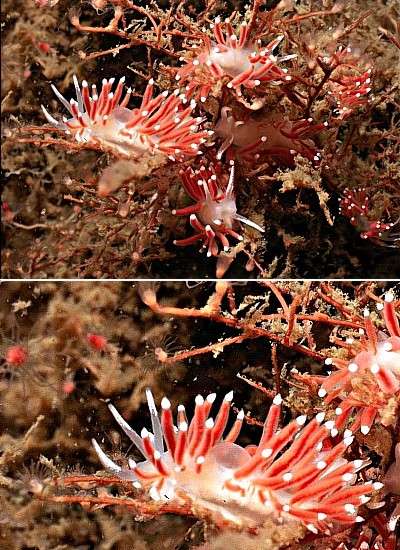
Bill,
This group of slides were taken on a night dive on a wreck at 73 feet (34 meters) just last week in the Atlantic Ocean off New York. I went about 10 feet along the wreck and came across a group of more than 50 of the same sea slugs. Needless to say, I didn't move from that spot until I was out of film. These were much smaller than the other two versions I had previously seen, and they were still laying eggs. Their color was also a much brighter red. I was again using a Nikonos V with a 1 to 1 macro. Length about 0.5 inches (12mm)
The Audubon Society Field Guide to North American Seashore Creatures shows something similar that is identified as Coryphella rufibranchialis. I also looked in the Marine Life of the North Atlantic by Andrew J. Martinez. He identifies these as Coryphella verrucosa, Coryphella pellucida, and Coryphella sp. with no information on how to tell them apart. The eggs he shows, however, are different from what I saw. His have a much neater pattern.
Best regards,
Betsey Hansen
BHScuba@aol.com
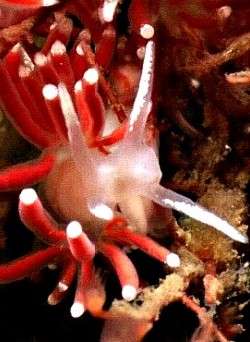
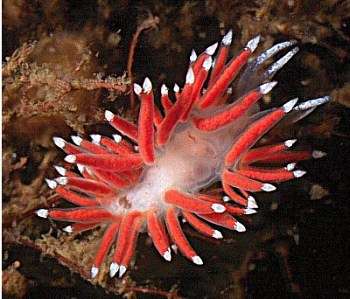
Dear Betsey,
At a guess I would say this is Flabellina gracilis but before I prepare a page, I'll wait until Terry or Sandra or some other kind person sets me straight.
Best wishes,
Bill Rudman.
